cisco 400-351 practice test
CCIE Wireless
Question 1
Which four options are the HTTP methods supported by a reset API?
- A. RETRIEVE
- B. GET
- C. PUT
- D. DELETE
- E. COPY
- F. POST
- G. SET
Answer:
B C D F
Question 2
Refer to the exhibit.
Which option describes what this sequence of commands achievers on a Cisco Autonomus AP?
- A. This example shows how to permit SNMP access to all objects with read-only permission to only those three specific IP addresses using the community string public. The access point also sends config traps to the hosts 192.180.1.111 and 192.180.1.33 using SNMPv1 and to the host 192.180.1.27 using SNMPv2C. The community string public is not sent with the traps because is the default community value.
- B. This example shows how to permit SNMP access to all objects with read-only permission to only those three specific IP addresses using the community string public. The access point also sends config traps to the hosts 192.180.1.111 and 192.180.1.33 using SNMPv1 and to the host 192.180.1.27 using SNMPv2C. The community string public is not sent with the traps.
- C. This example shows how to permit any SNMP manager to access all objects with read-only permission using the community string public. The access point also sends config traps to the hosts 192.180.1.111 and 190.180.1.33 using SNMPv1 and to the host 192.180.1.27 using SNMPv2C. The community string public is not sent with the traps as this is the default community value.
- D. This example shows how to permit any SNMP manager to access to all objects with read-only permission using the community string public. The access point also sends config traps to the hosts 192.180.1.111 and 190.180.1.33 using SNMPv1 and to the host 192.180.1.27 using SNMPv2C. The community string public is sent with the traps.
Answer:
D
Explanation: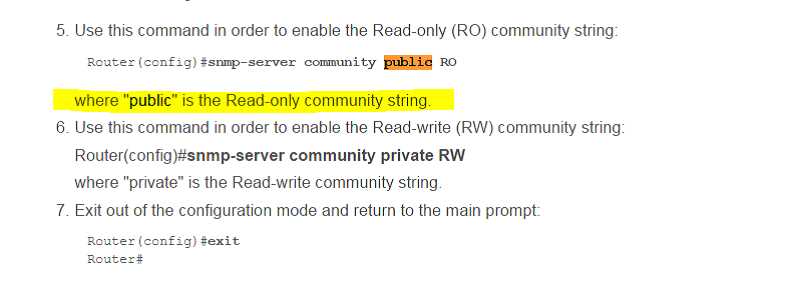
http://www.cisco.com/c/en/us/support/docs/ip/simple-network-management-protocol-snmp/7282-12.html
Confirmed: test in my demo switch, public default is ro
Question 3
Refer to the exhibit.
You are getting the following error message. Which reason for this issue true?
%DOT11-4-CANT_ASSOC Interface Dot 11 Radio0. Cannot associate NO Aironet Extension IE.
- A. “dot11 extension ” is missing under the interface Dot11Radio 0 interface.
- B. When repeater mode is used, unicast-flooding must be enabled to allow Aironet IE communications.
- C. The parent AP MAC address has not been defined.
- D. Repeater mode only works between Cisco access point.
Answer:
A
Explanation: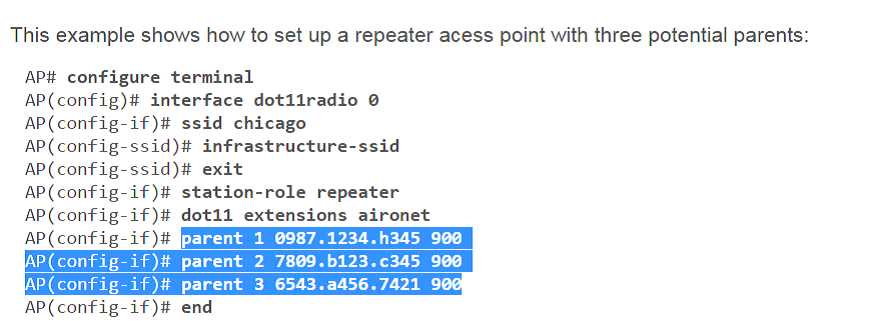
http://www.cisco.com/c/en/us/td/docs/wireless/access_point/12-2_11_JA/configuration/guide/b12211sc/s11rep.html
Question 4
You have received a new Cisco 5760 Controller and have gone through the initial startup wizard. You
are now trying to add APs to the controller, but these are not joining.
Which three checks should you do next? (Choose three.)
- A. Check that the radios are not in a shutdown state.
- B. Check the country code of the controller. The APs do not join the controller if the country code does not match.
- C. Check that the correct time is set on the controller.
- D. Check that option 53 has been set in the DHCP scope.
- E. Check that the controller has enough AP licenses.
- F. Check that the controller has been configured with the correct hostname. Otherwise, DNS resolution fails.
Answer:
BCE
Explanation: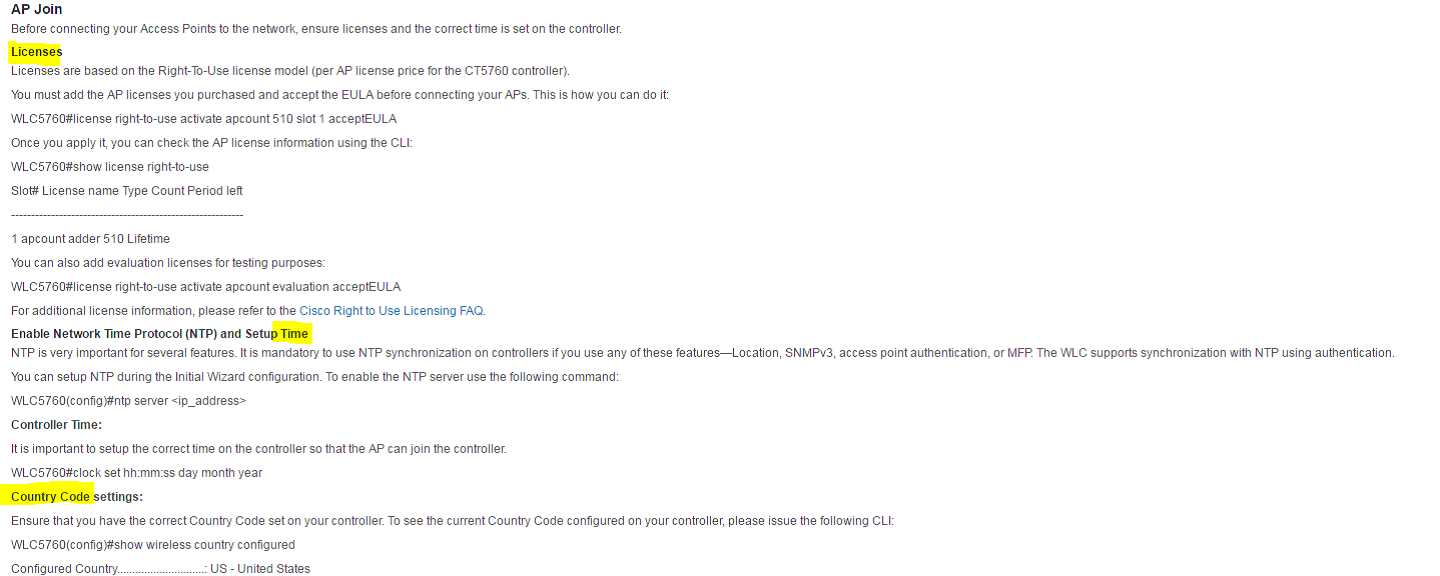
Question 5
You are installing Converged Access controllers that run Cisco IOS-XE and you are ready to implement
QoS. From the below, choose all the possible QoS target levels that would apply to downstream
traffic (toward the client)?
- A. Client, SSID, Radio, Port
- B. Client, SSID, Radio
- C. Client, Radio
- D. Client, SSID
Answer:
A
Explanation:
http://www.cisco.com/en/US/docs/switches/lan/catalyst3850/software/release/3.2_0_se/multibook/configuration_guide/b_consolidated_config_guide_3850_chapter_010010.html
Question 6
DRAG DROP
Drag and drop the CAPWAP event on the left into the order in which they occur on the right during
the WLC discovery and join processes.
Answer:
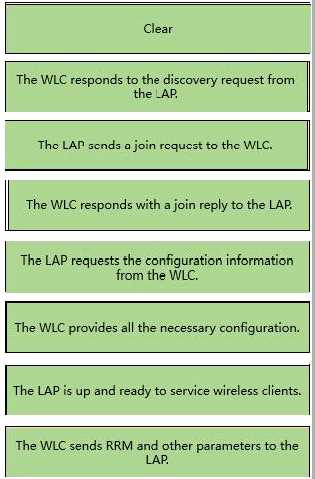
Question 7
Which memchanism incorporates the channel capacity into the CAC determination and gives a much
more accurate assessment of the current call carrying capacity of the AP?
- A. Static CAC
- B. Reserved roaming bandwidth(%).
- C. Expedited bandwidth.
- D. Metrics collection.
- E. Load-based AC
- F. Max RF bandwidth (%).
- G. Admission control.
Answer:
E
Explanation:
AP Call Capacity
A key part of the planning process for a VoWLAN deployment is to plan the number of simultaneous
voice streams per AP. When planning the voice stream capacity of the AP, consider the following
points:
Note: A call between two phones associated to the same AP counts as two active voice streams.
The actual number of voice streams a channel can support is highly dependent on a number of
issues, including environmental factors and client compliance to WMM and the Cisco Compatible
Extension specifications. Figure 9-11 shows the Cisco Compatible Extension specifications that are
most beneficial to call quality and channel capacity. Simulations indicate that a 5 GHz channel can
support 14-18 calls. This means a coverage cell can include 20 APs, each operating on different
channels, with each channel supporting 14 voice streams. The coverage cell can support 280 calls.
The number of voice streams supported on a channel with 802.11b clients is 7; therefore, the
coverage cell with three APs on the three non-overlapping channels supports 21 voice streams.
Figure 9-11 Cisco Compatible Extension VoWLAN Features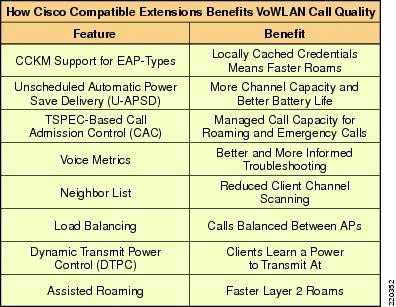
Call Admission Control (CAC) also benefits call quality and can create bandwidth reservation for E911
and roaming calls.
The 802.11e, WMM, and Cisco Compatible Extension specifications help balance and prevent the
overloading of a cell with voice streams. CAC determines whether there is enough channel capacity
to start a call; if not, the phone may scan for another channel. The primary benefit of U-ASPD is the
preservation of WLAN client power by allowing the transmission of frames from the WLAN client to
trigger the forwarding of client data frames that are being buffered at the AP for power saving
purposes. The Neighbor List option provides the phone with a list that includes channel numbers and
channel capacity of neighboring APs. This is done to improve call quality, provide faster roams, and
improve
battery
life.
http://www.cisco.com/c/en/us/td/docs/solutions/Enterprise/Mobility/emob41dg/emob41dg-wrapper/preface41.html
Understanding Static CAC
As mentioned previously, there are two types of Admissions Control. Static CAC is based on a
percentage of the total Medium Times available and is measure in increments of 32 microseconds. In
this section, we will cover how to configure Static and Load-Based CAC and also how to debug it.
http://www.cisco.com/c/en/us/td/docs/wireless/technology/vowlan/troubleshooting/vowlan
_troubleshoot/5_Troubleshooting_CAC_Rev1-2.html
Load-Based CAC on the other hand is significantly more difficult to debug. LBCAC is dynamic with
regard to the algorithm used to decrement Medium Times from the total that is available. LBCAC
takes into consideration different metrics, such as load, Co-channel interference, SNR, etc. and will
therefore yield different results when tested. From our experience, it is very difficult to yield
consistent results as RF fluctuates and changes within the given environment. Results tend to vary
from one cell area to another and even in cell areas that yield the same signal strength.
http://www.cisco.com/c/en/us/td/docs/wireless/controller/4-1/configuration/guide/ccfig41/c
41ccfg.html
o enable video CAC for this radio band, check the Admission Control (ACM) check box. The default
value is disabled.
n the Reserved Roaming Bandwidth field, enter the percentage of maximum allocated bandwidth
reserved for roaming video clients. The controller reserves this much bandwidth from the maximum
allocated bandwidth for roaming video clients.
Range: 0 to 25%
Default: 0%
in the Reserved Roaming Bandwidth field, enter the percentage of maximum allocated bandwidth
reserved for roaming voice clients. The controller reserves this much bandwidth from the maximum
allocated bandwidth for roaming voice clients.
Range: 0 to 25%
Default: 6%
To enable expedited bandwidth requests, check the Expedited Bandwidth check box.
The default value is disabled.
To enable TSM, check the Metrics Collection check box. The default value is disabled.
Traffic stream metrics (TSM) can be used to monitor and report issues with voice quality.
In the Max RF Bandwidth field, enter the percentage of the maximum bandwidth allocated to clients
for voice applications on this radio band. Once the client reaches the value specified, the access point
rejects new calls on this radio band.
Range: 40 to 85%
Default: 75%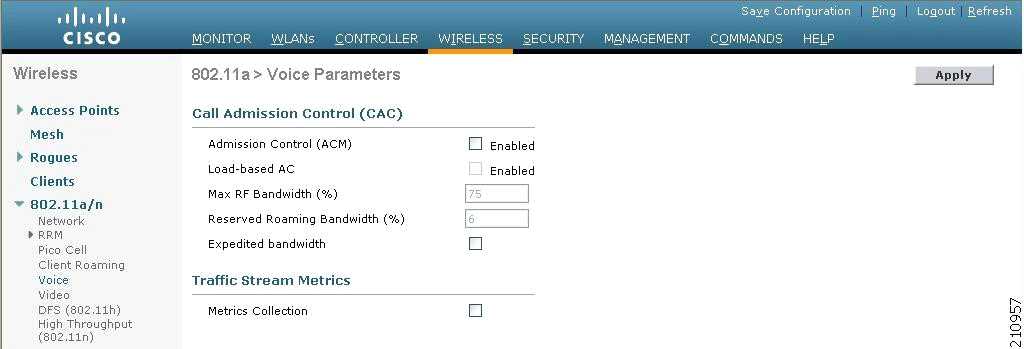
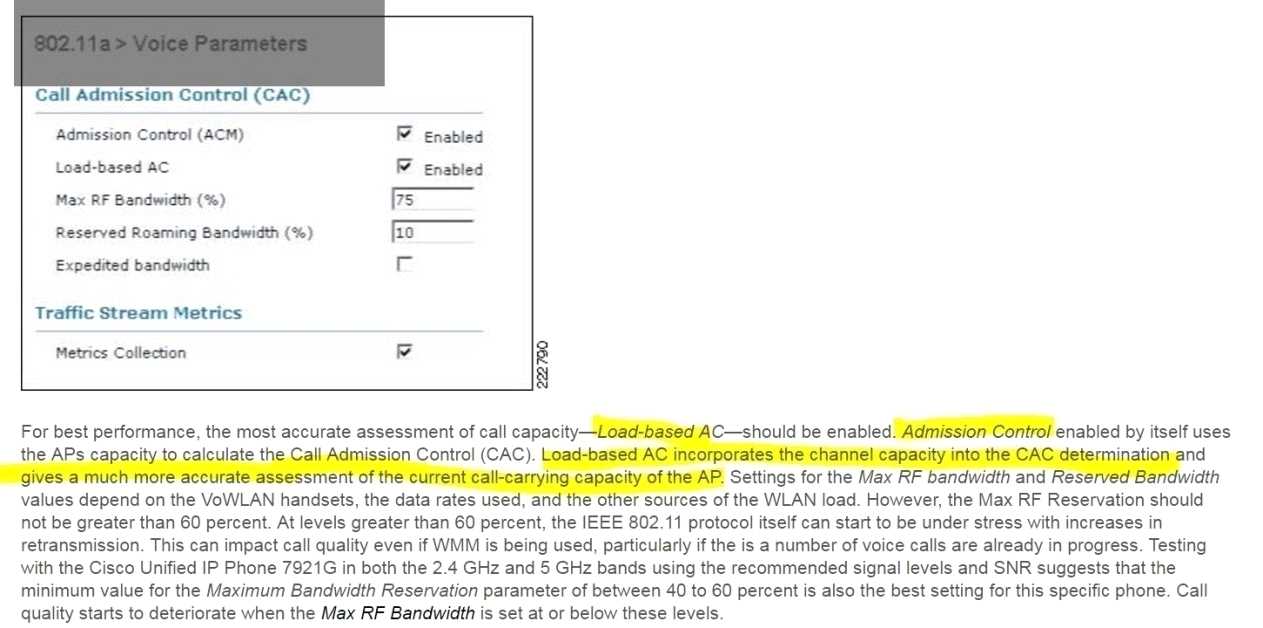
http://www.cisco.com/c/en/us/td/docs/solutions/Enterprise/Mobility/vowlan/41dg/vowlan41dg
-book/vowlan_ch8.pdf
Question 8
On a Cisco 5760 WLC, which of the below is not part of the initial setup script?
- A. Wireless management interface
- B. Host name
- C. HTTP server login account
- D. SNMP Network Management
- E. NTP server
- F. Enable password
- G. Default routing protocol
Answer:
G
Explanation:
From:
CT5760 Controller
and
Catalyst3850 Switch Configuration Example
-
Cisco
http://www.cisco.com/c/en/us/support/docs/wireless-mobility/wireless-vlan/116342-
config-wlc-00.html
5760 WLC Initial Configuration
This section outlines the steps to succesfully configure the 5760 WLC in order to host wireless
services.
Configure
Setup Script
--- System Configuration Dialog ---
Enable secret warning
----------------------------------
In order to access the device manager, an enable secret is required
If you enter the initial configuration dialog, you will be prompted for the enable secret
If you choose not to enter the intial configuration dialog, or if you exit setup without setting the
enable secret,
please set an enable secret using the following CLI in configuration mode- enable secret 0 <cleartext
password>
----------------------------------
Would you like to enter the initial configuration dialog? [yes/no]: yes
At any point you may enter a question mark '?' for help. Use ctrl-c to abort configuration dialog at
any prompt. Default settings are in square brackets '[]'.
Basic management setup configures only enough connectivity for management of the system,
extended setup will ask you to configure each interface on the system
Would you like to enter basic management setup? [yes/no]: yes
Configuring global parameters:
Enter host name [Controller]: w-5760-1
The enable secret is a password used to protect access to privileged EXEC and configuration modes.
This password, after
entered, becomes encrypted in the configuration.
Enter enable secret: cisco
The enable password is used when you do not specify an
enable secret password, with some older software versions, and some boot images.
Enter enable password: cisco
The virtual terminal password is used to protect access to the router over a network interface.
Enter virtual terminal password: cisco
Configure a NTP server now? [yes]: Enter ntp server address : 192.168.1.200
Enter a polling interval between 16 and 131072 secs which is power of 2:16
Do you want to configure wireless network? [no]: no
Setup account for accessing HTTP server? [yes]: yes
Username [admin]: admin
Password [cisco]: cisco
Password is UNENCRYPTED.
Configure SNMP Network Management? [no]: no
Current interface summary
Any interface listed with OK? value "NO" does not have a valid configuration
Interface
IP-Address
OK? Method Status Protocol
Vlan1 unassigned
NO
unset up
up
GigabitEthernet0/0
unassigned
YES
unset up
up
Te1/0/1unassigned
YES
unset up
up
Te1/0/2unassigned
YES
unset down down
Te1/0/3unassigned
YES
unset down down
Te1/0/4unassigned
YES
unset down down
Te1/0/5unassigned
YES
unset down down
Te1/0/6unassigned
YES
unset down down
Enter interface name used to connect to the
management network from the above interface summary: vlan1
Configuring interface Vlan1:
Configure IP on this interface? [yes]: yes
IP address for this interface: 192.168.1.20
Subnet mask for this interface [255.255.255.0] : 255.255.255.0
Class C network is 192.168.1.0, 24 subnet bits; mask is /24
Wireless management interface needs to be configured at startup
It needs to be mapped to an SVI that's not Vlan 1 (default)
Enter VLAN No for wireless management interface: 120
Enter IP address :192.168.120.94
Enter IP address mask: 255.255.255.0
The following configuration command script was created:
w-5760-1
enable secret 4 tnhtc92DXBhelxjYk8LWJrPV36S2i4ntXrpb4RFmfqY^Q
enable password cisco line vty 0 15
password cisco
ntp server 192.168.1.200 maxpoll 4 minpoll 4 username admin privilege 15 password cisco
no snmp-server
!
no ip routing
!
interface Vlan1 no shutdown
ip address 192.168.1.20 255.255.255.0
!
interface GigabitEthernet0/0 shutdown
no ip address
!
interface TenGigabitEthernet1/0/1
!
interface TenGigabitEthernet1/0/2
!
interface TenGigabitEthernet1/0/3
!
interface TenGigabitEthernet1/0/4
!
interface TenGigabitEthernet1/0/5
!
interface TenGigabitEthernet1/0/6
vlan 120
interface vlan 120
ip addr 192.168.120.94 255.255.255.0 exit
wireless management interface Vlan120
!
end
[0] Go to the IOS command prompt without saving this config. [1] Return back to the setup without
saving this config.
[2] Save this configuration to nvram and exit. Enter your selection [2]: 2
Building configuration...
Compressed configuration from 2729 bytes to 1613 bytes[OK]
Use the enabled mode 'configure' command to modify this configuration.
Press RETURN to get started!
Question 9
A Cisco Unified 7925G Wireless IP Phone is operating on the 5 GHz band and transmitting at a power
level of 40 mW. Which configuration must be done on the controller to avoid one-way audio?
- A. In DCA, enable UNH-1 channels only.
- B. Set the maximum power level assignment to 26 dBm.
- C. In DCA, enable UNII-II channels only.
- D. Set the maximum power level assignment to 16 dBm.
Answer:
D
Explanation:
https://www.cisco.com/c/en/us/support/docs/collaboration-endpoints/unified-wireless-ip-phone-7925g/200032-How-to-get-your-792x-wireless-phones-per.html
Question 10
Which two effects does TSPEC-based admission control have as it relates to WMM clients?(Choose
two.)
- A. Deny clients access to the VLAN that do not support WMM.
- B. Allow access only for VoWLAN traffic when interference is detected.
- C. Enforce airtime entitilement for wireless voice applications.
- D. Ensure that call quality does not degrade for existing VoWLAN calls.
- E. Deny clients access to the WLAN if they do not comply with the TERP standard.
Answer:
BE
Question 11
Your customer has a Cisco Unified Wireless Network running AireOS 8.0 and wants to learn about
the FlexConnect mode that is available on his APs. Which two statements are true? (Choose two.)
- A. A newly connected AP can be booted in FlexConnect mode.
- B. When an AP is changed from Local mode to FlexConnect mode, a reboot is required.
- C. Enhanced FlexConnect mode allows to enable wIPS on FlexConnect APs.
- D. When an AP is changed from Local mode to FlexConnect mode, reboot is not required.
- E. Using CCKM with FlexConnect APs requires the use of FlexConnect Groups.
- F. FlexConnect was previously know as "H-TEEP"
Answer:
DE
Explanation:
http://www.cisco.com/c/en/us/td/docs/wireless/controller/7-4/configuration/guides/consolidated/b_cg74_CONSOLIDATED/b_cg74_CONSOLIDATED_chapter_01000010.html
http://www.cisco.com/c/en/us/td/docs/solutions/Enterprise/Mobility/emob73dg/emob73/ch7_HRE
A.html
Question 12
Refer to the exhibit.
You are troubleshooting location accuracy problems on a customer deployment. You have done the
wireless design and you are sure that the As are correctly placed on the Cisco Prime map. Everything
is correctly synchronized between WLC, PI, and MSE but, you are sometimes getting elements
tracked on the wrong floor. After you get this debug output from MSE, which step is next?
- A. Reduce the confidence level on MSE when the last heard value is higher than 150 seconds.
- B. Run a new calibration model and ensure that it is applied on the floor.
- C. Discard RSSI values lower than – 75 dbm.
- D. Check it the AP with MAC address 001c 0f 4c 45 60 is physically located on the floor where the element was wrongly located and if the inter-floor attenuation is weak.
Answer:
C
Explanation:
http://www.cisco.com/c/en/us/td/docs/wireless/prime_infrastructure/1-
3/configuration/guide/pi_13_cg/maps.pdf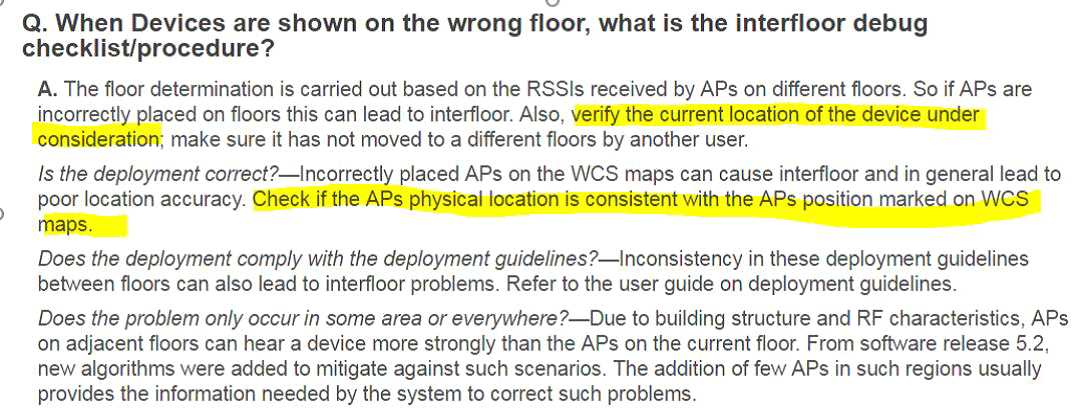
Question 13
Which two statements about deploying a mesh network by MAPs and RAPs are true on AireOS
8.0?(Choose two.)
- A. The backhaul client access feature cannot be enabled on a RAP that is, a RAP does not allow clients on its 302.11a radio.
- B. The three main types of mesh type under the neighbor information are neighbor, parent, and child. For types default neighbor, default parent, and default child, default is used when the neighbor BGN is not known or different from the current AP BGN if the strict matching BGN feature is disabled.
- C. A MAP/RAP must be authorized by either PSK or EAP before joining a controller in bridge mode
- D. RADIUS and Local authentications are supported with both PSK and EAP. VLAN tags are always forwarded across Mesh links.
- E. VLAN tags are always forwarded across Mesh links.
Answer:
BD
Explanation: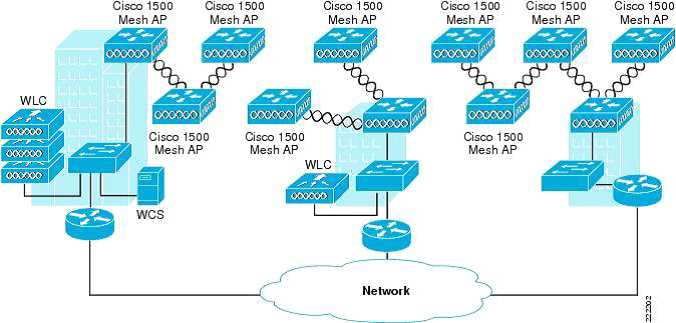
shows a simple mesh network deployment made up of mesh APs, WLCs, and a WCS. In this example
deployment, there are three mesh APs connected to the wired network. These APs are designated as
roof-top APs (RAPs); all other APs in the mesh network are known simply as mesh APs (MAPs). All
mesh APs, both MAP and RAP, can provide WLAN client access, however in most cases because of
the RAPs location it is not well suited for providing client access. In the following example the RAPs
are located on the roof of each of the buildings and are connected to the network at each location.
Some of the buildings have WLCs located at them to terminate LWAPP sessions from the mesh APs,
but it is not necessary for every building to have a WLC. LWAPP sessions can be back hauled across
the WAN if needed to other locations where a WLC resides.
Note PSK may be used in place of EAP if configured on the WLC.
Cisco Wireless LAN Controller Configuration Guide, Release 5.2 - Chapter 8 - Controlling Mesh Access
Points
[Cisco 4400
Series Wireless
LAN
Controllers]
-
Cisco
http://www.cisco.com/c/en/us/td/docs/wireless/controller/5-2/configuration/guide/Controller52CG/c52mesh.html#wp1542630
http://www.cisco.com/c/en/us/td/docs/wireless/controller/5-2/configuration/guide/Controller52CG/c52mesh.html#wp1474800
http://www.cisco.com/c/en/us/td/docs/wireless/technology/mesh/8-
1/design/guide/b_mesh_81/Connecting_the_Cisco_1500_Series_Mesh_Access_Points_to_the___.p
df
http://www.cisco.com/c/en/us/td/docs/wireless/technology/mesh/8-
0/design/guide/mesh80/Mesh_Network_Components.html
Question 14
Which three conditions can trigger a client exclusion policy?(Choose three.)
- A. Excessive 802.11 probe request failures
- B. Excessive 802.lx authorization failures
- C. IP theft or IP reuse
- D. Excessive 802.lx authentication failures
- E. Excessive 802.11 association failures
- F. Excessive 802.11 packet retries
Answer:
CDE
Explanation:
http://www.cisco.com/c/en/us/support/docs/wireless-mobility/wireless-lan-wlan/117714-technote-aireoswlc-00.html
Question 15
Which two features were added as part of the 802.llh amendment?
- A. Dynamic Frequency Selection and Direct Link Setup.
- B. Dynamic Frequency Selection and Transmit Power control.
- C. Dynamic Frequency Selection and Wireless Performance Prediction.
- D. Dynamic Frequency Selection and Inter-Access Point Protocol.
Answer:
B
Explanation:
http://www.cisco.com/c/en/us/support/docs/wireless-mobility/80211/200069-Overview-on-802-11h-Transmit-Power-Cont.html
http://www.cisco.com/c/en/us/td/docs/wireless/controller/8-1/Enterprise-Mobility-8-1-Design-Guide/Enterprise_Mobility_8-1_Deployment_Guide/wlanrf.html